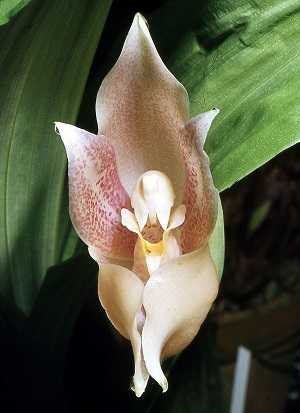Anguloa orchids form a very small genus of only 9 species.
The most famous species in this genus is Anguloa uniflora.
They are found in South America in the following countries:
- Colombia
- Ecuador
- Peru
- Bolivia
- Venezuela
This genus was discovered in 1794 by Ruiz López and José Antônio Pávon.
The name was a tribute to Don Francisco de Agulo, an orchid collector who lived in Peru.
These are terrestrial or ground orchids, but in some cases, they can also be epiphytic.
Learn How to Achieve Super Blooms on Your Orchids
🛑 If you love orchids and you're tired of not being able to make them bloom...
Then, know that thousands of beginner growers are achieving beautiful flowers on their orchids by following this method.
Click the button below to have beautiful orchids with show-worthy flowers every year. ⤵
How to Care for Anguloa Orchids
To care for any orchid, you must provide certain factors for it.
These factors are the pillars for it to be healthy and not contract diseases.
Below, you will learn what these factors are and how to provide them for your anguloa.
Lighting
These orchids really enjoy sunlight.
So, make sure they are placed in a well-lit area, both in summer and winter.
To find out if your orchid is getting too much or too little sun, check out the article on orchid leaf spots.
Humidity and Watering
These orchids prefer medium to high humidity.
Regarding watering, water them more frequently during their growth period.
Afterward, reduce watering to encourage flower production.
Also, check out:
Temperature
Anguloa orchids live in higher altitudes.
Usually, they can be found between 1500 and 2000 meters.
Therefore, they really like lower temperatures and less ventilation.
It is a great orchid to be cultivated in the south of Brazil, but it may not adapt well to the northeast.
Fertilizer
Fertilizer helps orchids have more energy.
Anguloa also needs proper fertilization.
Use water-soluble NPK 20-20-20, especially during the growth period.
Usually, fertilize every 15 days.
Repotting
Repotting occurs approximately every 2 years.
To know if it’s time to repot your orchid, you should check some factors:
- Is your pot broken?
- Is your soil too old?
- Is the plant larger than the pot?
If your answer is yes to one or more of the questions above, it’s time to repot.
Since they are terrestrial, just follow the same repotting tips for paphiopedilum.
Growing Medium
The growing medium should provide good drainage and aeration for your plant. It should also be able to retain moisture without becoming waterlogged.
Some recommended growing media for orchids include:
- Pine bark
- Charcoal
- Peat
- Sphagnum moss
- Coconut fiber
- Perlite
- Vermiculite
You can mix these or other growing media to create a custom blend that meets the specific needs of your orchid.
Do You Want to Learn How To Keep Your Orchids Healthy And Ready to Bloom Every Year?
So, I prepared a complete guide, step by step and illustrated, that will show you:
• The secrets to getting beautiful flowers every year
• How to fight and identify pests and diseases on your orchids
• THE MAGIC SUBSTANCE for orchids and how to use it
• And much, much more.
The great news is that the manual is now available at a super discount!!
But beware, it's only for the first buyers.
Click on MORE INFORMATION below and discover the secrets to show-worthy flowers. 👇
Where to Plant
This orchid can be planted in the ground, with plenty of humus.
But this is not the most recommended place.
To plant them in the ground, make sure your species is terrestrial.
You can also plant them in terracotta or plastic pots.
Conclusion
This was the guide on how to care for anguloa orchids.
If you own one of these plants or would like to have one, leave your comment below.
Share your experience with this plant or how you met this species.
If you liked this article, help us out.
Share it on your social media by clicking the icons below, because that way, you help us reach more people.






















